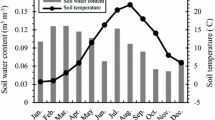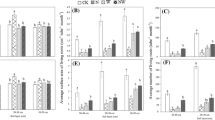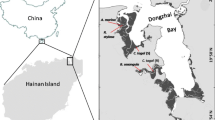Abstract
Fine root turnover is a major pathway for carbon and nutrient cycling in forest ecosystems. However, to estimate fine root turnover, it is important to first understand the fine root dynamic processes associated with soil resource availability and climate factors. The objectives of this study were: (1) to examine patterns of fine root production and mortality in different seasons and soil depths in the Larix gmelinii and Fraxinus mandshurica plantations, (2) to analyze the correlation of fine root production and mortality with environmental factors such as air temperature, precipitation, soil temperature and available nitrogen, and (3) to estimate fine root turnover. We installed 36 Minirhizotron tubes in six mono-specific plots of each species in September 2003 in the Mao’ershan Experimental Forest Station. Minirhizotron sampling was conducted every two weeks from April 2004 to April 2005. We calculated the average fine root length, annual fine root length production and mortality using image data of Minirhizotrons, and estimated fine root turnover using three approaches. Results show that the average growth rate and mortality rate in L. melinii were markedly smaller than in F. mandshurica, and were highest in the surface soil and lowest at the bottom among all the four soil layers. The annual fine root production and mortality in F. mandshurica were significantly higher than in L. gmelinii. The fine root production in spring and summer accounted for 41.7% and 39.7% of the total annual production in F. mandshurica and 24.0% and 51.2% in L. gmelinii. The majority of fine root mortality occurred in spring and summer for F. mandshurica and in summer and autumn for L. gmelinii. The turnover rate was 3.1 a−1 for L. gmelinii and 2.7 a−1 for F. mandshurica. Multiple regression analysis indicates that climate and soil resource factors together could explain 80% of the variations of the fine root seasonal growth and 95% of the seasonal mortality. In conclusion, fine root production and mortality in L. gmelinii and F. mandshurica have different patterns in different seasons and at different soil depths. Air temperature, precipitation, soil temperature and soil available nitrogen integratively control the dynamics of fine root production, mortality and turnover in both species.
Similar content being viewed by others
References
Anderson L J, Comas L H, Lakso A N, Eissenstat D M (2003). Multiple risk factors in root survivorship: a 4-year study in Concord grape. New phytologist, 158: 489–501
Bloomfield J, Vogt K A, Wargo P M (1996). Tree root turnover and senescence. In: Wiasel Y, Bshel A, Kafkafi U, eds. Plant Roots: The Hidden Half (second edition, revised and expanded). New York: Marcel Dekker, Inc., 363–381
Burke M K, Raynal D J (1994). Fine root growth phonology, production, and turnover in a northern hardwood forest ecosystems. Plant and Soil, 162: 135–146
Burton A J, Pregitzer K S, Hendrick R L (2000). Relationships between fine root dynamics and nitrogen availability in Michigan northern hardwood forest. Oecologia, 125(3): 389–399
Canadell J, Jackson R B, Ehleringer J B, Mooney H A, Sala O E, Schulze E D (1996). Maximum rooting depth of vegetation types at the global scale. Oecologia, 108(4): 583–593
Cheng Y H, Han Y Z, Wang Q C, Wang Z Q (2005). Seasonal dynamics of fine root biomass, root length density, specific root length and soil resource availability in a larix gmelini plantation. Acta Phytoecologica Sinica, 29: 403–410 (in Chinese)
Craine J, Tremmel D (1995). Improvements to the minirhizotron system. Bulletin of the Ecological Society of America, 76: 234–235
Eissenstat D M, Yanai R D (1997). The ecology of root lifespan. Advances in Ecological Research, 27: 1–60
Eissenstat D M, Yanai R D (2002). Root Lifespan, efficiency, and turnover. In: Waisel Y, Eshel A, Kafkafi U, eds. Plant Roots: The Hidden Half. 3rd Edition. New York: Marcel Dekker, Inc., 221–238
Fahey T J, Hughes J W (1994). Fine root dynamics in a northern hardwood forest ecosystem, Hubbard Brook Experimental Forest. Journal of Ecology, 82: 533–548
Farrar J F, Jones D L (2000). The control of carbon acquisition by roots. New Phytologist, 147: 43–53
Fogel R (1985). Roots as primary producers in below-ground ecosystems. In: Fitter A H, Atkinson D, Read D J, Usher MB, eds. Ecological interactions in soil: Ecological interactions in soil: plants, microbes and animals. Oxford (UK): Blackwell, 23–36
Gill R A, Jackson R B (2000). Global patterns of root turnover for terrestrial ecosystems. New phytologist, 147: 13–31
Hendrick R L, Pregitzer K S (1992). The demography of fine roots in a northern hardwood forest. Ecology, 73: 1094–1104
Hendrick R L, Pregitzer K S (1993). The dynamics of fine root, length, biomass, and nitrogen content in two northern hardwood ecosystems. Canadian Journal of Forest Research, 23: 2507–2520
Hendrick R L, Pregitzer K S (1996). Applications of minirhizotrons to understand root function in forests and other natural ecosystems. Plant and Soil, 185: 293–304
Huang J H, Han X G, Chen L Z (1999). Advances in the research of (fine) root biomass in forest ecosystems. Acta Ecologica Sinica, 19: 270–277 (in Chinese)
Jackson R B, Reynolds H L (1996). Nitrogen and ammonium uptake for single-and mixed-species communities grown at elevated CO2. Oecologia, 105(1): 74–80
Johnson M G, Tingey D T, Phillips D L, Storm M J (2001). Advancing fine root research with minirhizotrons. Environmental and Experimental Botany, 45(3): 263–289
Joslin J D, Henderson G S (1987). Organic matter and nutrients associated with fine root turnover in a white oak stand. Forest Science, 33: 330–346
Li P Z, Fan S H, Wang L H, Xu S M (2001). Productivity and turnover of fine roots in poplar tree and grass roots. Chinese Journal of Applied Ecology, 12: 829–832 (in Chinese)
Majdi H (1996). Root sampling methods-applications and limitations of minirhizotron technique. Plant and Soil, 185: 255–258
Matamala R, Gonzàlez-Meler M A, Jastrow J D, Norby R J, Schlesinger W H (2003). Impacts of Fine Root Turnover on Forest NPP and Soil C Sequestration Potential. Science, 302(5649): 1385–1387
Mei L, Han Y Z, Yu S Q, Shi J W, Wang Z Q (2006). Impact Factors on Fine Roots Seasonal Dynamics in Manchurian ash Plantation. Scientia Silvae Sinicae (in Chinese), (in press)
Mei L, Wang Z Q, Cheng Y H, Guo D L (2004). A review: factors influencing fine root longevity in forest ecosystem. Acta Phytoecologica Sinica, 28(5): 704–710 (in Chinese)
Norby R J, Jackson R B (2000). Root dynamics and global change: seeking an ecosystem perspective. New Phytologist, 147: 3–12
Powell S W, Day F P Jr (1991). Root production in four communities in the Great Dismal Swamp. American Journal of Botany, 78 (2): 288–297
Pregitzer K S (2003). Woody plants, carbon allocation and fine roots. New Phytologist, 158(3): 421–423
Pregitzer K S, Zak D R, Maziasz J, DeForest J, Curtis P S, Lussenhop J (2000). Fine root growth, mortality, and morphology in a factorial elevated atmospheric CO2 × soil N availability experiment. Ecological Applications, 10: 18–33
Raich J W, Nadelhoffer K J (1989). Belowground carbon allocation in forest ecosystems: Global trends. Ecology, 70: 1346–1354
Schenk H J, Jackson R B (2002). The global biogeography of roots. Ecological Monographs, 72(3): 311–328
Shan J P, Tao D L, Wang M, Zhao S D (1993). Fine roots turnover in a broadleaved Korean pine forest of Changbai Mountain. Chinese Journal of Applied Ecology, 4: 241–245 (in Chinese)
Shi J W, Yu S Q, Yu L Z, Han Y Z, Wang Z Q, Guo D L (2006). Application of Minirhizotron in Fine Root Studies. Chinese Journal of Applied Ecology (in Chinese) (in press)
Steele S J, Gower S T, Vogel J G, Norman J M, (1997). Root mass, net primary production and turnover in aspen, jack pine and black spruce forests in Saskatchewan and Manitoba, Canada. Tree Physiology, 17(8–9): 577–587
Tierney G L, Fahey T J (2001). Evaluation of minirhizotron estimates of fine root longevity in the forest floor of a temperate broadleaf forest. Plant and Soil, 229: 167–176
Vogt K A, Gxier C C, Vogt D J (1986). Production, turnover and nutrient dynamics of above-and belowground detritus of world forests. Advances in Ecological Research, 15: 303–377
Vogt K A, Vogt D J, Palmiotto P A, Boon P, O’Hara J, Asbjornsen H (1996). Review of root dynamics in forest ecosystems grouped by climate, climatic forest type and species. Plant and soil, 187(2): 159–219
Wells C E, Glenn D M, Eissenstat D M (2002). Soil insects alter fine root demography in peach (Prunus persica). Plant, Cell and Environment, 25(3): 431–439
Zhang X Q, Wu K H (2001). Fine root production and turnover for forest ecosystem. Scientia Silvae Sinicae, 37(3): 126–138 (in Chinese)
Zhang X Q, Wu K H, Murach D (2000). A review of methods for fine-root production and turnover of trees. Acta Ecologica Sinica, 20(5): 875–883
Author information
Authors and Affiliations
Corresponding author
Additional information
Transtlated from Journal of Plant Ecology, 2007, 31(2): 333–342 [译自: 植物生态学报]
Rights and permissions
About this article
Cite this article
Shi, J., Wang, Z., Yu, S. et al. Estimation of fine root production, mortality and turnover with Minirhizotron in Larix gmelinii and Fraxinus mandshurica plantations. Front. Biol. China 3, 496–506 (2008). https://doi.org/10.1007/s11515-008-0084-0
Published:
Issue Date:
DOI: https://doi.org/10.1007/s11515-008-0084-0




